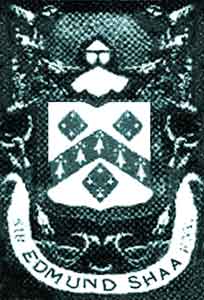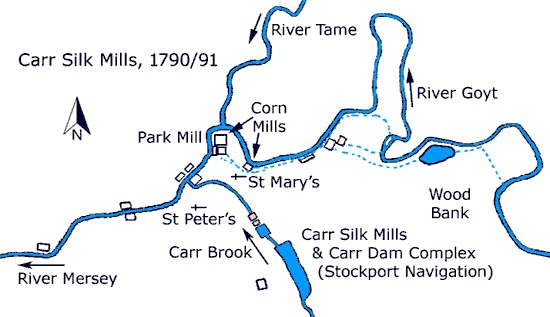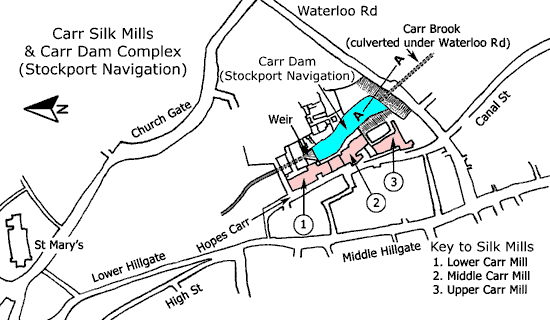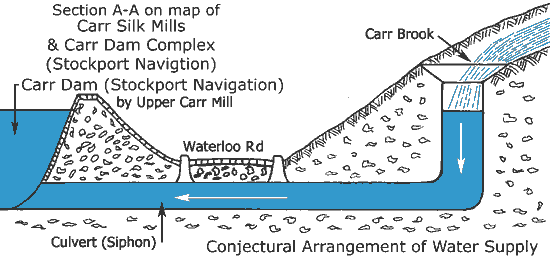
Stockport is an ancient town (NoteOriginally called 'Stopford' or 'Stockford', the origins of Stockport can be traced back to 1188.) and in a curious twist of fate the Stockport Navigation brought together two eminent men of their day who were separated from each other by over three centuries. The first was Sir Edmund Shaa and the second was Samuel Oldknow.
Sir Edmund Shaa Kt PC (c.1427-20 Apr 1488), founder of Stockport Grammar School
The Shaa family is of great antiquity in the county of Cheshire and Edmund Shaa was born in the vicinity of Mottram-in-Longdendale to parents who came from Dukinfield.
Little is known about his early life except that his family was of modest means, so as a young man he resolved to move to London. It was said that he was:
···· of gentle birth, yet the artificer of his own great fortune, he was a man of outstanding ability and unmistakable piety, eminent in his profession, high in public office and esteem, the valued friend and coveted supporter of kings ····

In 1450 the youthful Edmund Shaa was apprenticed, in the City of London, to one Robert Botteler, a Goldsmith, who is known to have been flourishing by 1432 and dead by 1470. Edmund, by all accounts, succeeded brilliantly with his apprenticeship. He became the Court Jeweller for Edward IV (NoteFollowing the death of Edward IV, he was succeeded by his 12-year-old son who became Edward V. His uncle, Richard, Duke of Gloucester, became Protector and he imprisoned Edward, together with his younger brother, Richard. The fate of the two 'Princes in the Tower' is unknown. Consequently, Edward V was only King between April and June 1483 when Gloucester became Richard III.), Richard III and Henry VII.
When Edward IV died he was succeeded by the very young Edward V and one of his few acts was to confer on Alderman Edmund Shaa the rank of Privy Councillor.
However, Richard, Duke of Gloucester, was patiently awaiting his chance to become King and, for unknown reasons, Edmund Shaa gave Richard his unreserved support. Edmund Shaa actually offered him the crown at Baynard's Castle, City of London, and the event was recorded in a painting. Richard III became king on the 26 Jun 1483 and his coronation was on the 6 Jul 1483. The day before his coronation he knighted Alderman Edmund Shaa for his support.
Sir Edmund received two commissions from the King. The first, on the 8 Aug 1483, was '···· to attend to the defences at the mouth of the Thames ····' and the second was of Oyer and Terminer. The latter appointment meant that he had become a Judge of the Assize (NoteOyer and Terminer was originally an Anglo-Norman term meaning to hear and determine. A commission was issued from the 13th century to justices to hear pleas of the crown (serious crimes). Formerly, special justices, outside the slow-functioning 'eyres' (court circuits), were commissioned for this purpose but Oyer and Terminer gradually became a commission of the 'justices of assize' (legislative enactments). By 1972 the assize courts had all been abolished, their criminal jurisdiction being exercised by the Crown Court and their civil jurisdiction by the High Court.).
On the 20 Mar 1488, Sir Edmund made his Last Will and Testament and one month later on 20 Apr 1488 he died. Fortunately, his very detailed Will has survived.
Sir Edmund lay in state in London at the Church of St Peter in Cheapside and he was buried at the Hospital of St Thomas of Acre (aka Mercers Chapel). St Thomas is the martyred Thomas Becket. His widow and three children were later buried beside him. Sadly, the Great Fire of London in 1666 destroyed the Hospital of St Thomas of Acre along with Sir Edmund’s tomb and little chapel.
In his Will, Sir Edmund remembered the people and town of Stockport and he left several bequests, one of which was for the 'Parisshe Church of Stopford' (St Mary's in the Marketplace) and another was for the founding of a school in the 'Parisshe of Stopford, in the said Countie of Chestre' (Stockport Grammar School). He also left a bequest for the building of the tower of the Church of St Michael & All Angels at Mottram-in-Longdendale. Sir Edmund's parents were actually buried in the family tomb at St Mary's Church.
The centuries went by until eventually most folk were unaware of this great benefactor to the town of Stockport. In 1810 it was decided to demolish the original Parish Church of St Mary and during this process the tombs were wantonly scattered, including the tomb of the Shaa family where generations of Stockport Grammar School boys had said the 'De Profundis' (NoteThe 130th Psalm, expressing deep misery.). The Shaa family memorial stone, easily identifiable by its Coat of Arms, was taken with all the others to a tip that was in an area of Stockport to become known as 'Waterloo'. It lay there for a while, to be eventually removed and embedded in the wall of an outhouse to a cottage that was being built in the vicinity. Eventually someone remembered that there was a memorial stone for the Shaa family but an antiquarian of the day failed to find this ancient relic.
Samuel Oldknow, Mill Owner & Industrialist
Samuel Oldknow (5 Oct 1756-18 Sep 1828) is better remembered today for his Mellor Mill, for lime burning, and for being a proprietor of the Peak Forest Canal Company.
He was a major promoter of the canal's construction. Prior to this, he had extensive business interests in Stockport and his house stands on Higher Hillgate, a short distance away from Canal St.
This street is opposite Hopes Carr off the south side of Waterloo Rd.
On his arrival in Stockport in 1784 he initially occupied a warehouse and Carr Silk Mills* for use as cotton-spinning mills while his own mill was being built on Higher Hillgate. These water-powered mills were known as Lower Carr, Middle Carr and Upper Carr. However, it seems that Oldknow decided to construct a reservoir to maintain a sufficient head of water to power the waterwheels at all times. This was known as the Carr Dam but in reality it was the Stockport Navigation. Its length was short, coinciding with the length of Middle Carr and Upper Carr Mills, and it was only as wide as the terrain of this narrow valley would permit. Oddly, it had a substantial embankment at its 'upper' end and there must also have been a weir by Lower Carr Mill. In any event, an embankment at the upper end meant that Carr Brook had to be culverted under Waterloo Rd and then further upstream of the reservoir for some distance. This was necessary in order to ensure that the head of water in the reservoir was below the open water of Carr Brook. In other words, some kind of siphon action was required as a failure to get the levels of the culvert right would have resulted in the reservoir not filling properly.



In order to build an embankment for the reservoir, suitable materials were needed, so what better than to have a look at a nearby tip where a plentiful supply of stone was to be found. Some of these stones were grave headstones and memorial stones but this was of little importance. The people commemorated on the stones were certainly not within living memory and, especially as no-one seemed to know very much about them, it seemed reasonable to use them in the embankment and that is what happened. Moreover, few people at that time could have read the inscriptions on the stones.
Apparently, the memorial stone to the Shaa family was unearthed, complete with its Coat of Arms. It was not necessary to be able to read in order to understand that this particular stone was more important than the others as the Coat of Arms said it all. Seemingly, some consideration was given to saving the stone but the story goes that, in spite of its apparent importance, it went into the embankment.
Anyhow, the Shaa family memorial stone has never been found and the truth can never be known without its discovery. And so it was, in a twist of fate, that the histories of the two eminent men touched each other at the Stockport Navigation. Happily, the memorial plaque for Samuel Oldknow in the tower of All Saints, Marple, has survived but it very nearly did not.
Boats on the Stockport Navigation
Another question concerns the existence of boats on the Stockport Navigation, otherwise the name of Canal St would seem inappropriate. Seemingly, there were boats but it is a matter of conjecture as to what type
they were, how many there were and what they carried. A clue may be found at the nearby Compstall Navigation where wrought-iron tub boats plied along the short mill reservoir there. In plan view, these boats were of
rectangular shape and they were hauled by horses but, as they were not fitted with rudders, they were steered by a pole that could slot into any one of four rowlocks fitted to the gunnels.
In the case of the Stockport Navigation it is considered that similar tub boats could have been used but, because of the smaller size of the reservoir, these were probably both propelled and steered using poles.